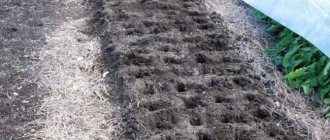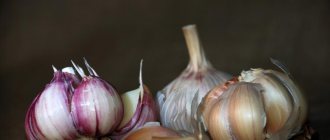How to prepare a bed for winter garlic for planting in the fall: green manure and fertilizers
Before you start sowing winter garlic, you need to prepare the bed. This procedure consists of several stages:
- Choosing a suitable place that needs to be changed every year, and not occupy the old one for 2-3 years.
- Soil disinfection. To do this, you can use copper sulfate in a proportion of 1 tbsp. l. substances per 10 liters of water.
- Digging up soil and applying fertilizers. Usually these 2 processes are interconnected, since useful substances are laid under the soil layer.
- Watering and forming grooves for planting. In some cases, you can plant in holes - it all depends on the preferences of the gardener.
Bed ready for planting
When all the preparatory steps have been completed, you can begin planting the winter variety of garlic. But if all the processes are more or less clear, then how to fertilize the soil before planting garlic remains a question.
There is a huge variety of fertilizing techniques and types of substances that can provide a nutrient environment for a plant to grow and develop. From this entire set, you need to choose only those options that are suitable for the culture represented.
Using green manure
Gardeners often use an agrotechnical soil preparation procedure called green manuring. It is as follows: before planting the main crop, a green manure plant (mustard, winter rye, oilseed radish, oats, rapeseed, phacelia) is sown, which is then introduced under the soil layer during digging.
Planting in mustard
Important! Cross crops should not be used as green manure. For example, you cannot sow mustard in a place where cabbage grew.
Green manure is used to improve the structure of the soil, enriching it with useful and organic substances and minerals. Winter garlic grows best on the basis of the following green manures:
- Mustard. It releases substances into the soil that kill the main pests of garlic.
- Phacelia. Improves soil composition due to phytosanitary properties and good biomass.
- Barley. If there is absolutely no choice, then you can use this green manure. But this crop will not reproduce any special changes in the composition of the soil necessary for garlic.
Sowing of auxiliary plants is carried out no later than 2 weeks before planting the main crop. It is better to sow in rows so that beds for garlic can be formed between them.
Is it necessary to fertilize
A rich harvest of garlic can be harvested only if the root system of each plant is fully developed. And problems often arise with this. The root of the crop is weak, poorly developed, and occupies a small area. If there are also few useful substances in the soil, then the yield will be represented by a small number of small heads of dubious quality.
Comparison (with and without fertilizer)
Fertilizing the soil in the process of preparing beds will become the main problem for a gardener who wants to increase the size of the heads and generally increase the germination of the crop. After adding nutrients at the beginning and periodically fertilizing during the growth period, you can get a good harvest without any problems.
Landing highlights
Before planting, the heads are divided into cloves, choosing the largest ones (they will give more roots).
Many gardeners pre-soak them for a day in warm water with the addition of a fungicidal agent and a growth stimulant. Winter cloves are planted to a depth of 6-10 cm, depending on the type of soil:
- on loams and chernozem, the cloves are closed to 6-7 cm;
- on deeper sandy ones - 9-10 cm.
The cloves are placed at a distance of 6-8 cm from each other, about 20 cm are left between the rows
The planting depth for spring is 2-3 cm. Detailed recommendations for planting and growing it can be found in the article on our website.
The soil should be moist. It is watered after planting, and the dry one is additionally moistened before sowing.
When planting winter varieties of garlic, the soil surface must be mulched with a layer of peat, straw, sawdust (4-5 cm thick) to provide additional protection from the cold.
Preparing beds for fertilization
When planting in the fall, fertilizer for garlic is not spread over the area where the crop will be planted in the future. The soil must first be prepared, and only then fertile material should be laid. For these purposes, the following is carried out:
- First, green manure is planted as the first preparatory stage of the soil.
- In the autumn, it is placed under a layer of soil to rot.
- The land is thoroughly disinfected. Copper sulfate, manganese, burgundy mixture or boric acid can be used as a disinfectant.
- Preliminary digging of the soil is carried out, during which weeds are removed along with the roots.
Disinfection
How to prepare a bed for winter crops in the fall so that the plant is not infected with pathogenic microorganisms? Fungi accumulate in the ground in the fall, and the garlic may die before it even begins to grow.
Sterilize the soil by treating it with a solution of copper sulfate. Dilute a tablespoon of the substance in ten liters of water and spill the soil. To improve the disinfection process, cover the bed with film for a day or two.
Cloves prepared for planting also require disinfection. They are soaked in a weak solution of potassium permanganate for twenty to thirty minutes.
How do fertilizers for winter garlic differ from fertilizers for spring garlic?
Before deciding what to fertilize garlic with, you also need to take into account the type of crop. There are winter and spring garlic. The same substances can be used to feed and fertilize these varieties, but at different times. For example, before winter, you should not apply chemical mineral fertilizers with nitrogen for winter crops - such an additive can provoke accelerated growth of the above-ground parts. And, on the contrary, a garden bed for spring crops can be generously enriched with this product, including at the very beginning.
Preparing the bed
Before the onset of winter, the plant needs time to form a well-developed root system. Organics can help with this - for 2 varieties it is mandatory to use from the very beginning. They also need to be fed according to different schemes, differing in the proportions of the components included in them.
Rules for planting garlic in the ground
- It is better to grow varietal garlic, which will allow you to hope for a good harvest and high quality products. Before planting, gardeners divide the garlic heads into cloves and then plant them in previously prepared furrows. If the garlic cloves are not planted immediately after separation, they will be successfully stored for several days at a temperature not exceeding +4 °C. Varietal garlic can be purchased at garden and garden stores.
- For planting by division, it is better to choose medium-sized heads (4-5 grams). To fill one square meter of planting bed you will need from 100 to 350 grams of garlic cloves. The reason for this large range is, firstly, the size of the mother garlic heads, and secondly, the interval at which the cloves will be planted. Typically, larger cloves are planted less frequently, while smaller ones are planted more densely. At the discretion of the gardener, the distance between the garlic rows can be from 20 to 30 cm wide, and the range of spaces between the cloves stuck into the ground ranges from 5 to 10 cm.
- Planting depth is important. Due to the need for overwintering, garlic is planted a little deeper in the fall than in the spring. It is correct to plant so that the clove is located deep in the soil and covered with at least a 5-centimeter layer of soil. Therefore, they are placed at a depth of 5-8 cm in a vertical position. Planting too deep can hinder the growth of leaves in the future, and planting too shallow can freeze, even despite the high resistance of this plant to low temperatures.
- When planting, the garlic clove is stuck into the ground with its wider side; there is an undeveloped root system there. The pointed end of the segment is the upper part of the future plant. If planted incorrectly, the garlic will not grow large or will not form correctly. Therefore, garlic is planted by hand.
- A successful place for growing garlic will be the place where potatoes, celery or cucumbers were previously grown. It is necessary to avoid planting garlic for two years in the same place or after onions, as this can lead to the development of fungal diseases. In addition to this requirement, the garlic bed requires careful weeding.
- In autumn, garlic is planted by vegetative propagation (by dividing the bulb into slices or sown with seeds). Planting time is from mid-September to mid-October. Earlier or later planting reduces crop yield. Thus, the last date for planting is approximately October 20. It is important that autumn planting allows you to achieve higher yields than spring planting. The most important disadvantage of garlic planted before winter is that it is stored worse than that planted in the spring.
- In the northern regions, a bed with garlic planted in the fall must be covered with mulch (straw, humus, hay or leaves) for the winter. A mulch cover, like a blanket, will protect the bulbs from frost. In mild climates, mulching is not necessary; however, it can help protect garlic from freeze/thaw cycles. Mulch will also help retain heat in the soil of the bed longer, which will allow the garlic roots to grow longer and take root better.
Mulching should be done in late fall, usually November, when cold weather has firmly established itself. Keeping the garden bed mulched until cold weather sets in will help prevent bulbs from rotting in warm, moist soil conditions. In humid areas where winters are mild, mulching is not recommended (especially on heavy clay soils). In spring, the mulch is removed, this promotes rapid thawing and heating of the soil.
Also learn how to plant garlic cloves.
Video: Proper planting of garlic in the fall
It would be interesting to know what to feed and how to water garlic after winter.
Did you know? Drinking whole or skim milk before, during, or after eating foods high in garlic can reduce bad breath. This is because milk reduces the concentration of garlic compounds that produce a sulfur odor.
Growing garlic is a simple process; the grower only needs experience and knowledge. To get a good harvest of a medicinal vegetable, the gardener is required to properly prepare the seed and provide the garlic bed with good care: proper fertilizer, loosening and watering.
What to put in a hole to make it grow big
Small heads of garlic are a sign of problems with soil nutrition and insufficient care. To obtain large material, you need to perform root feeding, which is carried out at the time of planting.
Additional Information! In addition to complex fertilization of the soil under the bed, useful substances are placed in the hole or trench itself. This is called root feeding.
But what kind of substance to choose for this becomes a problem for an inexperienced gardener. You can use chemicals, organic substances (humus, ash, manure), and mineral fertilizers. In each case, the instructions for use will be completely different.
Feeding with chemicals
Fertilizers for garlic can be of chemical origin. Usually their use is due to the lack of an organic analogue. Most often used:
- Potassium salt or potassium sulfate. They will improve yields, increase resistance to pests and diseases, and extend shelf life.
- Superphosphate, phosphate rock. These funds will help significantly accelerate the growth and development of culture.
- Urea, saltpeter (any type), ammonium sulfate. They are aimed at improving the growth of the aerial part.
Chemical fertilizers
Note! You should not use potassium chloride, since Cl can cause the death of the entire crop.
Such fertilizers must be applied in accordance with the needs of the plant - you cannot use such products thoughtlessly. To determine the correct proportions, you must first read the instructions.
Mineral fertilizers
You also need to apply mineral fertilizers. They contain many nutrients that help grow healthy crops. Ideal options would be complexes such as ammophos, nitrophoska, nitroammophoska. Thanks to them, the garden bed will bloom in a riotous color, since the above-ground part will receive a sufficient amount of nutrients. An added bonus is the large heads that store well.
Organic (ash, manure, humus)
Regarding whether garlic loves ash, the answer is simple - of course, it loves and demands it. This natural fertilizer is applied at the beginning of activities, when preparing the planting site. This fertilizer contains a lot of potassium, phosphorus and calcium. In this sense, garlic and ash are ideally suited to each other when planting.
Organic
500 g of dry ash is added per 1 m² of land. You can first mix it with manure or humus. Organic ingredients will be an excellent basis for vigorous growth and good development of the crop.
What kind of manure to apply under garlic
In the process of preparing the soil, you need to add manure to it in the proportion of 1 bucket of mullein per 1 m². You can additionally add mullein at a time when the holes have already been formed - this is called root feeding.
Additional Information! In addition to mullein, you can also use chicken manure, but only 500 g of such fertilizer is enough for 1 m², since the material is saturated with ammonia.
Manure for garlic
Winter garlic needs a large amount of nutrients that help it survive the winter normally and easily enter the active growth phase in the spring. It is not recommended to add fresh manure or humus - this can negatively affect the plant due to the abundant release of ammonia. Natural fertilizer should be dried and partially loose.
Let's start landing
Prepared garlic is planted in beds prepared according to all the rules and in fertilized soil. Pour 3 cm of clean river sand into furrows 15 cm deep. It needs to be shed well. Garlic is placed in it with the sharp part facing up. It is necessary to maintain the distance between the cloves. Then the garlic is covered with earth and covered with sawdust, straw, and pine needles. You can cover the beds with roofing felt before the snow falls.
The bulbs are planted in grooves 5 cm deep on moistened sand. They are also sprinkled with earth and mulched. Some gardeners plant bulbs in newspapers with holes. Sprinkle the top with soil and mulch. It is believed that this method allows you to forget about weeds in the beds.
Fertilizer application scheme in autumn
Nutrients must be added according to certain standards. Thoughtless use of additives can cause irreparable damage or even kill plants. An approximate diagram of how to feed garlic in the fall when planting, and how it is done, looks like this:
- 1-2 weeks before planting, you need to dig up the soil, mixing it with manure or humus.
- Afterwards, wood ash is added to it and then the soil is dug again (it is acceptable to simply loosen the soil with a rake).
- Mineral fertilizers are placed in holes or trenches (but you can also add them during the digging process, but not earlier than a week after organic additions).
Autumn fertilizers
The composition of the nutrient mixture can be as follows: rotted manure (4 kg), potassium salt (25 g), double superphosphate (35 g). Additionally, compost (5 kg) and superphosphate (20 g) are added to it.
When is the best time to plant garlic?
Determining the most favorable period is not difficult; you just need to monitor the air temperature outside, which should be +12...+15 °C by the time the garlic is planted. Typically this temperature is set in late September or early November. But do not forget about the variability of climate in different years and the planting region, since the period of onset of the desired temperature regime will depend on the combination of these factors.
In addition, the period for planting garlic can be calculated depending on the onset of the first cold weather. Thus, the cloves should be planted approximately a month and a half before the arrival of the first frost.
Did you know? Planting garlic for the winter is a more natural process than growing it in summer. This is due to genetic memory, because the ancestor of garlic is the pointed onion, which grows in the mountainous regions of Central Asia, where there is eternal winter.
But the bulbs need to be planted even earlier - in order for them to take root well, it is better to place the bulbs in the ground no later than April. This period is necessary so that the planted cloves and bulbs have time to take root, which are usually 10–20 cm long, which will allow the plants to better withstand the winter and produce good shoots in the spring. Also, newly planted cloves may hatch before the weather gets cold, but this is a good sign, indicating that the garlic has taken root and even the most severe frosts cannot harm it.
But what it’s better not to do is plant garlic too early, otherwise the crop will have time to germinate fully and will disappear before spring. The same applies to late planting - the cloves and bulbs simply do not have time to take root and freeze, which will naturally lead to a complete loss of the harvest.
Fertilizer consumption rates for different types of soils
If the land is poor in useful components, then an integrated approach is needed - almost all types of nutrients (except nitrogen) can be used to enrich it. This restriction applies only in the fall, since the vigorous growth of leaves of the winter variety is undesirable before wintering.
Most often, depleted areas are treated with the following means:
- superphosphate (40-50 g per m²);
- potassium sulfate (5-10 g per m²);
- azophos brand (NPK 16:16:16) (40-60 g per m²).
During the period of growth and development, you also need to feed, but in a more gentle amount. In this case, it is worth taking into account the previously used (autumn) complex of nutrients.
Choosing a place for a garden bed
The place where garlic is planted also plays an important role. It is important to remember that this crop cannot be planted in the same bed every year. Experienced gardeners recommend moving the garlic bed to a new location every season, since garlic can only be returned to the old area after 3-4 years.
A good choice for planting this crop would be a former bed with:
- pumpkins;
- legumes;
- early cabbage;
- early greens;
- cucumbers;
- bushes of berries and all annual plants.
They need to be removed from the beds in advance, and not on the eve of planting the garlic.
Important! If something used to grow in the garden bed where you decided to grow garlic, then you need to remember that this crop must be removed no later than the end of August or beginning of September.
.
A bad choice for placing planting material would be a bed where tomatoes, potatoes and onions were grown, since when planted in these places, garlic will grow very poorly due to the depletion of the soil by these crops. In addition, these plants are removed from the plots too late and you simply may not have time to prepare the soil for planting.
Among other things, we must not forget that garlic loves the sun very much, so the bed should be located in a well-lit, open area. If possible, care should be taken to ensure that the crop is not covered by shadow, even if it turns only briefly.
The soil should be loose, not allow air and excess water to pass through. In addition, the soil must be sufficiently nutritious and have a neutral pH level. In order for your garden bed to meet these parameters, you need to take care of the composition of the soil on it a month before planting the planting material.
You should not plant garlic in areas where dirt forms and rainwater stagnates, as well as on dense, clayey and acidic soil. You should avoid soil that contains a large amount of peat in its impurities.
Garlic can be planted in sandy areas, the crop will grow there, but very poorly. Due to the properties of sand, you will have to constantly water the beds abundantly and carefully fertilize the soil, but even with this care the heads turn out to be too small.
Spring activities and feeding for growing garlic
In the spring, when the snow has already melted and green sprouts appear, you can make the first fertilizing. It is performed as follows:
- Prepare a mixture of 1 part manure and 10 parts water (this portion is enough for 1 m²).
- The resulting solution is used to treat the desired area of land.
- If the leaves become pale, then wood ash is additionally used. The soil is sprinkled with it, after which watering is organized.
Similar actions are repeated after 2 weeks. And at the beginning of June it is already allowed to apply mineral fertilizers.
Feeding rates
Sometimes, before June feeding, if the condition of the soil requires it, it will be necessary to feed it with ash. To do this, fertilizer is sprinkled between the rows and then abundant watering is carried out.
How to determine what garlic is missing
Feeding garlic is a very important condition for high-quality plant care - this crop cannot do without an infusion of nutrients. But when enriching the land, you need to know exactly what the crop is missing.
Garlic, like onions, reacts to a lack of certain minerals in the soil by changing the color of the above-ground parts. So, for example, if the lower leaves at the base of the head begin to turn yellow, it means there is not enough potassium. When red streaks appear on them, we can conclude that there is a nitrogen deficiency. A low and thin trunk indicates a lack of organic compounds. If growth is slow and the sprouts look weak, then it is necessary to add nitrogen fertilizers, which will help speed up the development of the plant.
Problems with leaves
To make up for all the shortcomings in the growth process, when re-feeding it is better to use complex fertilizers.
It is not enough to simply put garlic cloves in the soil and wait for a rich harvest - you need to take care of preparing the bed. Particular attention should be paid to the application of fertilizers. In addition to standard humus, it is necessary to use mineral and organic fertilizers. Additionally, it is worthwhile to enrich the soil during the growing season of the plant.
Selection of predecessors
You need to think in advance about how to prepare the soil for planting garlic in the fall. An important role is played by what kind of neighbors the garlic bed should have. The best predecessors are cucumbers and zucchini. But vegetables - garlic and onions do not go well with each other. Although the vegetable with its smell repels pests of garden and vegetable crops, raspberries and grapes do not tolerate such proximity. Vegetable crops inhibit the development of the root system of berry plants.
Tomatoes and cucumbers can withstand proximity to aromatic plants. Vegetables, along with zucchini and beans, will supply the soil with nutrients. But for carrots, the pungent smell of the plant will repel the pest - the onion fly, but the crop will not grow well next to the carrot beds.
A bed for garlic before winter should be planned in advance, and its predecessors should be taken care of as early as possible.
In mid-August, the planted crops are harvested. The soil after green manure will be filled with the elements necessary for plant growth.
A mixture of oats, peas and mustard is planted along the bed in the fall. By October, the seedlings will have grown, and their stems will be covered by vegetable plantings. During the winter, green manure will retain the snow in the garden bed and protect the seedlings from frost.
In spring, rotten parts of plants will become an excellent organic fertilizer.
How acidic should the soil be?
One of the most important indicators of soil quality when growing garlic is its acidity level.
The acidity level should be low and not low - Ph 6.5 - Ph 7. This vegetable crop will not withstand an environment that is too acidic and too alkaline, in which the garlic bulb will not be able to develop properly.
IMPORTANT! You don’t need to change soil acidity levels yourself if you don’t have the necessary tools. You can buy a soil acid meter or a set of special litmus papers at a hardware store.
To change the acidity level of the soil, you need to use specialized purchased mixtures to reduce or increase the level.
Popular varieties of garlic
Before you start planting garlic for the winter, you should understand the issues of choosing the right variety. There are 2 types of garlic:
- winter - more frost-resistant (can withstand down to -25°C), which are planted in the fall, are distinguished by large segments of 4-12 pieces. (even number) in each head, the taste is more pungent, suitable for consumption and preparations, but is poorly stored;
- spring varieties - they are distinguished by smaller slices, the number of which is 8-20 pieces, low winter hardiness, can be stored until spring, the taste is mild.
For planting in the autumn months, it is better to choose winter varieties that will withstand wintering well in the soil and then produce an early harvest.
The most popular winter varieties:
- Alcor is a bolting, high-yielding variety, the bulbs are large, weighing up to 40 g;
- Grodekovsky - winter-hardy, good yield, medium-sized bulbs, harvested 80-90 days after germination;
- Autumn - a universal, high-yielding variety, the bulbs are large and dense, weighing up to 36 g, distinguished by a purple tint of scales;
- Podmoskovny is a mid-season variety, the heads are large, weighing up to 60 g, planting is carried out in September to a depth of 8-10 cm;
- Komsomolets - mid-season, cold-resistant, the bulbs are flat in shape, color - white with purple streaks;
- Lyubasha is a productive variety, the heads are large, with 7 lobes, the color is white-pink with purple veins, and has a long shelf life.
Useful tips
To get a high-quality harvest, follow all recommendations . Beginning summer residents often make basic mistakes, due to which they ultimately do not get the expected result.
Common mistakes:
- The location of the bed is below. Due to excess moisture, the heads will rot.
- Planting time is one of the key points. The crop should be planted when the nights have already become cold and the days remain warm.
- Insufficient insulation. If the garden bed is not covered with enough snow in winter, the garlic will freeze.
- The shoots must be removed, otherwise all the nutrients will not remain in the head, but will go into the air bulbs.
- In spring and summer, do not forget about watering and fertilizing.
Seed treatment
Soaking seeds in potassium permanganate
To enhance the resistance and increase the resistance of garlic to diseases and low temperatures, it is useful to treat the seeds. The following compounds can be used to disinfect them:
- Manganese (potassium permanganate);
- Copper sulfate;
- Salt;
- Ash wood.
- You can also disinfect planting material with ready-made chemicals: Fitosporin and Maxim fungicide.
One of the powerful antiseptics that suppresses many fungal diseases and pathogenic microorganisms is manganese. It not only disinfects the garlic cloves, but also nourishes them with potassium.
The most important thing when preparing a solution is not to overdo the concentration, otherwise the garlic cloves may get badly burned. The powder should be thoroughly mixed with water so that all the crystals dissolve and the mixture acquires a slightly pinkish tint. The cloves are immersed in the solution for several hours. If the plant material is healthy and not damaged, 1 hour is enough for disinfection. Otherwise, you will have to keep the garlic in the solution much longer - up to 10 hours.
Ash alkali
Processing garlic with ash solution
The materials used are ash, pine or birch trees, corn and sunflower stalks, rye and buckwheat straw.
When ash powder dissolves in water, dust particles settle to the bottom. Potassium and calcium hydroxides, which have a pronounced alkaline reaction, are added to the solution. This solution protects the garlic cloves from nematode infestation. In addition, ash alkali is an effective mineral fertilizer that improves plant growth.
To prepare an alkaline mixture, dilute the ash (3 cups) in water (3 liters). Heat the mixture over low heat, being careful not to bring it to a boil. After cooling, pour the transparent part into a separate container and immerse the garlic cloves in it for 1-2 hours.
Disinfection with copper sulfate
One of the means that helps disinfect garlic for planting before winter is copper sulfate. To do this, dissolve 5 g of the substance in 1 liter of water, mixing thoroughly. Then the garlic cloves are kept in the solution for no more than 10 minutes. During this time, the solution will have time to be absorbed into the skin.
After removing the garlic, spread it on paper or a napkin to dry. The copper sulfate remaining on the surface of the cloves after drying is sufficient to protect the crop from possible diseases.
Other solutions
Some gardeners process winter planting material in several stages. Garlic cloves are disinfected one at a time in three solutions:
Nitroammophoska (1 tsp) is diluted with warm water (10 l). Soak the garlic in this solution for one day. Dissolve table salt (1 tsp) in water (1 liter) and keep the cloves for no more than 20 minutes. Mix copper sulfate (1 tsp) with water (1 bucket). Immerse the plant material in the mixture for no more than 1 minute. After drying, the plant material can be planted in the beds.
Use of chemicals
If individual garlic cloves show signs of disease, it is recommended to use ready-made chemical preparations.
To combat garlic diseases before autumn planting, the following fungicides are used:
- Fitosporin-M protects the plant from root rot, late blight, scab, powdery mildew and many other diseases. It is available in paste, powder or liquid form. The paste form of the drug is the most convenient and economical. To prepare the solution, 100 g of paste is diluted in 1 glass of water. Since the solution is highly concentrated, it should be diluted with water before use. To soak garlic cloves, dilute 8 drops of the solution in 0.5 liters of water. Keep the plant material in the solution for 2 hours.
- Powder "Maxim" is intended for sanitary treatment of all root crops and soil. Available in liquid form. One ampoule is enough to process 1 kg of garlic. The drug is dissolved in water (1 l) and the garlic cloves are immersed in the solution for 30 minutes. All disinfectant solutions should be used in a cool place to avoid germination.
Thus, preparing garlic for planting before winter is not at all difficult. All disinfectants are quite easily available. Having prepared the site properly and completed all the steps for selecting and disinfecting planting material, you don’t have to worry about the future harvest.
To be able to harvest garlic in June, gardeners plant it before winter. The ideal time for planting winter garlic is between the third ten days of September and the first and second ten days of October, depending on the region. There are no special tricks in planting vegetables, but still many people make common mistakes that lead to crop loss. Take note of such errors to account for them in the future.
Choosing the right place
Garlic is very picky about soil and predecessors. Never plant winter garlic in the same place as the previous year: leave the soil for at least 4 years, and only then add garlic to the site. It is also undesirable to place vegetables after planting potatoes, tomatoes, carrots and beets. But after harvesting zucchini, zucchini, cucumbers, parsley and cilantro, garlic can be safely planted; it will like this soil.
Garlic is a light-loving plant, so when choosing a place for planting, give preference to an area without trees, tall shrubs and fruit crops. Garlic can be planted in raised beds or directly into the ground. However, keep in mind that low-lying areas are not the best place for planting: the accumulation of excess moisture from melting snow and spring rains can ruin the harvest.
Dense sowing
Sowing garlic before winter
Garlic cloves should be planted at a distance of at least 7-8 cm from each other, and if the cloves are large, then up to 15 cm. The idea is to make sure that the plants do not interfere with each other's growth, since planting too often will lead to the appearance of small and underdeveloped heads.
First, separate the garlic cloves before planting, but do this very carefully so as not to damage the skin. If the seeds turn out to be “naked”, it is better not to use them, but to leave them for making borscht. Only whole cloves are suitable for sowing. This is because the husk protects the plant from pests and pathogens, without which the clove would most likely die.
Secondly, division should be carried out immediately before planting, if possible in the evening. Cloves that have been in the ground for a long time quickly dry out and do not germinate.
Winter garlic should be planted at least a month before the onset of frost to give it time to take root. Garlic grows well in loose, fertile soil. Therefore, before planting it is necessary to prepare the ground:
- Clear the bed of weeds;
- Treat the bed with herbicide (if necessary);
- Dig (to a depth of at least twenty centimeters) or loosen (if the soil is soft) the soil;
- Use fertilizers and microelements;
- Level the area to avoid excess moisture;
- Water the soil.
Preparation should be carried out some time before planting so that the soil is saturated with nutrients and stabilized a little. If garlic is planted immediately after processing, the cloves may sink deeper and germinate much later in the spring.
Soil fertilization
Tilling the soil before planting
Nitrogen fertilizers are well suited for spring feeding of garlic in the spring, but applying them before wintering would be a big mistake. This is due to the fact that nitrogen activates feather growth, which is not at all necessary before the onset of cold weather. If you want to fertilize the plant, use phosphorus-potassium fertilizer.
Garlic is an elegant and healthy vegetable, and to get a bountiful harvest, the gardener just needs to avoid these mistakes.
Before doing this, it is important to know what type of soil you have on your site. If it is clayey, add raising agents - river sand or peat; if it is sandy, provide frequent watering; if it is too acidic - wood ash or dolomite flour.
All these ingredients normalize the composition of the soil. And to increase its fertility, it is necessary to add humus or compost (organic fertilizer). You can also use mineral fertilizers - superphosphate and potassium sulfate.
Do not apply nitrogen fertilizers before fall planting. It can be used in the spring to feed seedlings.
Preparing the bed for winter
Sheltering garlic for the winter
To ensure your garlic survives the winter well, prepare your garden bed for cold weather. Once the garlic is planted, covering it with mulch, straw or pine branches will help during hard frosts and retain essential moisture in the soil.











